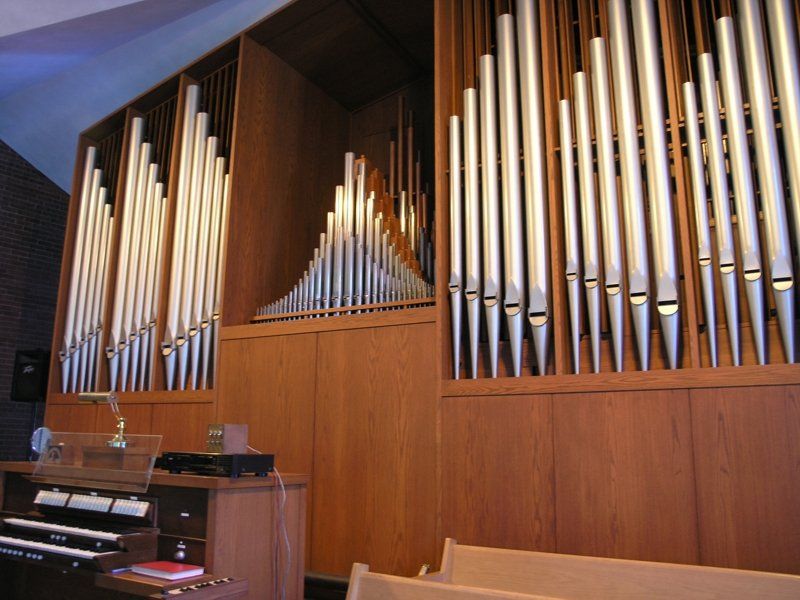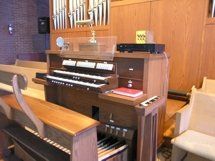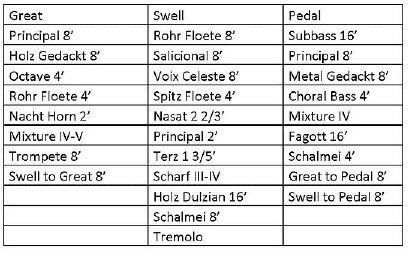
Sanctuary Organ
George Mitchell Williams Pipe Organ
The George Mitchell Williams Pipe Organ, located in the sanctuary organ loft, was custom built in 1973 by the Schlicker Organ Company, of Buffalo, New York. In March, 2010 the instrument was rededicated to the glory of God and in memory of NCC's venerable Organist/Music Director of 42 years who had been so instrumental in its selection and design.
In 2016, under the supervision of NCC's Organist/Music Director (2009-2019), James Brian Smith, the Sanctuary organ underwent renovation and repair. The work was completed in just under three months by Ericksen, Christian and Associates of Glen Elyn, Illinois. This fine instrument is one again at its fullest voice.
ABOUT THE INSTRUMENT
As one looks at the instrument, one sees there are three sections: The middle section has the pipes for the lowest keyboard, called the Great. To the south (right) are the pipes for the Swell, so called because it has shutters, like Venetian blinds, that open or close permitting expression of sound. To the north (left) are the pipes for the pedals, played by the feet. The display pipes in the front of the swell and pedal sections are arranged as they are for visual effect.
The pipes of each section are set on three large rectangular boxes called "chests," each weighing 500 pounds. The organ uses mechanical action, which is also referred to as tracker, action. The action of an organ is a term used to describe mechanical means of how the keys enable the pipes to sound. In tracker action, the organist is in direct control of the pallet allowing air into the pipe. It is therefore the most artistic action. Many components comprise tracker action. The names and functions of these components are:
- Trackers – the portions of the action used to make a pulling motion. Trackers can be used over long distances. They are thin strips of wood, roughly 1 cm wide and 2 mm thick. Although flexible, at rest they hold their shape. Playing a note pulls on the end nearer to the keyboard, so they are in tension while the note is playing. The term comes from the Latin verb trahere, to draw (pull).
- Stickers – used for a pushing motion; often paired with trackers. Their length is limited by the material, though most of the time, capping off at about 10 inches.
- Levers – used to transfer from a tracker (pulling) to a sticker (pushing), or a general change of direction, or both.
- Backfalls – used for motion over a small or short distance where trackers and stickers would be otherwise illogical to use. As a natural result, the motion also changes direction.
- Squares – a specific type of lever commonly used in organs which is at a right (90°) angle. Squares can also come in a “T” shape and form.
- Rollers – wooden shafts, which rotate. Used for parallel direction in vertical or horizontal motion. They have small levers on each end, like cranks.
- Roller board – location upon which rollers are attached (note: rollers are often used densely in one section of the action and so are often closely associated with the roller board.)
- Stops – knobs which indirectly control the flow of air over certain ranks of pipes. They are activated with a pulling motion by hand, and deactivated (or stopped) by pushing them shut.
- Trundle – used as a substitute for levers in the action associated with the Stops and Slider boards.
- A model of the mechanical action of an organ was built by Jim Hutten from spare parts from the installation of the Schlicker Organ and is on display outside the choir room.
The different sounds of the organ along with their respective on/off switches are called stops. The total listing of stops is called a specification.
A more recent addition to the organ is a zimbelstern, made by Casavant, which was installed in 2010. Zimbelstern means "cymbal-star". Zimbelsterns used to be made in the shape of a star with small bells at each point. The star was turned, either manually or pneumatically, and the bells were struck by stationary clappers mounted around the star - much like a child’s pinwheel.
Modern zimbelsterns are electrically operated. The bells do not rotate. Instead, a rotating device in the center strikes the bells. The sanctuary organ zimbelstern is constructed in the latter fashion.



